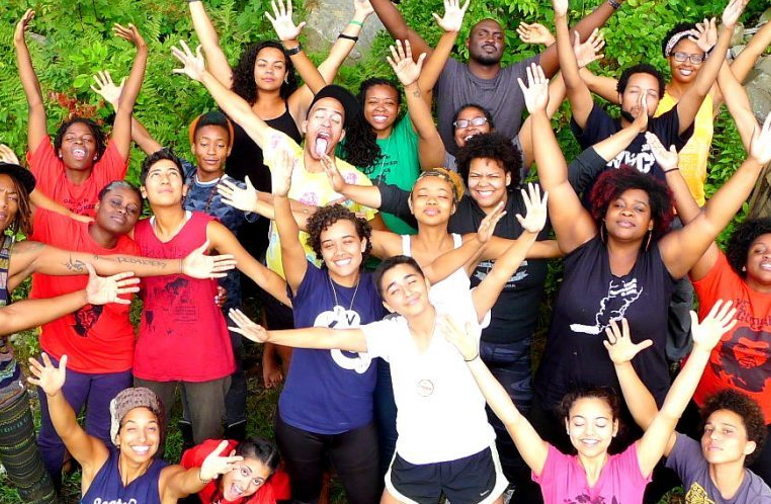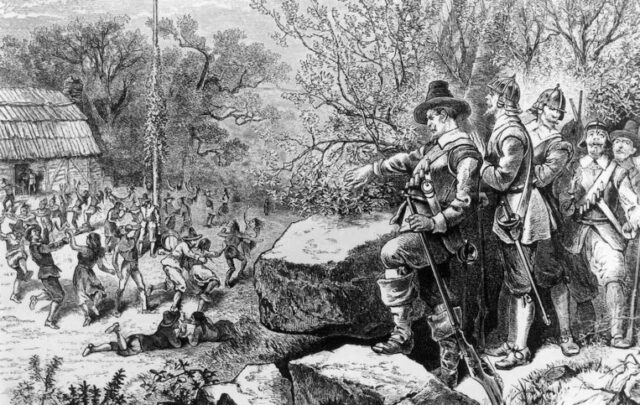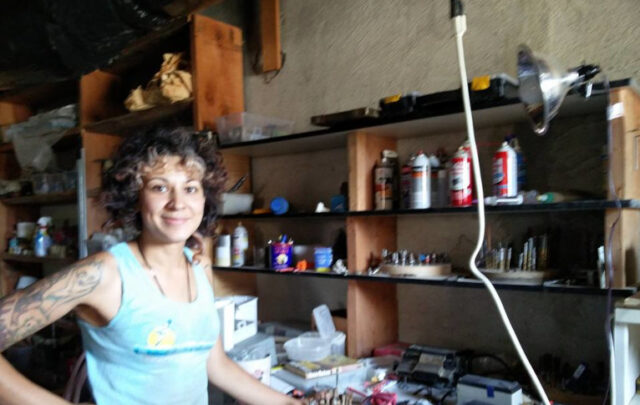The world is facing a climate crisis and the changes this brings is dramatically impacting farmers across the world. As temperatures rise and rainfall becomes increasingly unpredictable, production is dropping, and businesses are struggling. However, in the United States, climate change still divides opinion. Many still question its scientific validity, including the President who said climate change was ‘an expensive hoax’ and pulled the US out of the Paris Agreement. However, in opposition to those climate-deniers, there are passionate and engaged people across America who are desperately working to keep us within the two-degree Celsius limit. In light of that division, we wanted to talk to farmers across the US to understand how they view climate change and what steps (if any) they were taking to address it.
The SFT will run this series over the coming months, featuring a diverse range of American farmers. This week, we interviewed Larisa Jacobsen, Co-Director and Partnerships Director of Soul Fire Farm.
Soul Fire Farm is located on 80-acres of land that historically was stewarded by the Stockbridge-Munsee Band of the Mohican Nation. The Mohican people were forcibly removed from their territory in the 1800’s to a reservation in northern Wisconsin. The farm has been building a relationship with members of the community over the past several years. Soul Fire Farm also runs an extensive range of community-focused engagement programmes and training. The soils on the land are mostly Buckland (“very stony loam”). The farm community ‘believes that the Land is a relative, not a commodity’, and they use divination tools from West Africa to ask permission of the Land before making any major changes. Their regenerative, carbon sequestering farming practices, such as no-till, cover crops, mulch, compost, raised beds, agroforestry, silvopasture, and native species restoration, are part of that covenant to care for the Land.
What are your biggest concerns about climate change and its effect on your farm in particular?
 One of our largest concerns is that we, like many Black, indigenous and other people of colour land stewards in the United States, due to the nature of land costs and the difficulty in barriers to securing stable land tenure, farm on what is called ‘marginal land’. So, we’re on hillsides with a pretty steep slope; the land had been eroded over time due to prior practices. We have somewhat limited resources to implement new systems, so the land is more vulnerable to climate change and extreme weather events, and particularly to soil erosion.
One of our largest concerns is that we, like many Black, indigenous and other people of colour land stewards in the United States, due to the nature of land costs and the difficulty in barriers to securing stable land tenure, farm on what is called ‘marginal land’. So, we’re on hillsides with a pretty steep slope; the land had been eroded over time due to prior practices. We have somewhat limited resources to implement new systems, so the land is more vulnerable to climate change and extreme weather events, and particularly to soil erosion.
We’re also in a far north latitude, so that can make us more susceptible to extreme weather as well, to changes in the seasons and in pest and weed patterns. As a result of changing climate and weather over time, there are differences in how crops grow at the tail end of the season, particularly in spring and fall, when they may be more susceptible to cold or sudden heat or storms.
Our concerns for the farmers in our network through our work with Black, indigenous and other people of colour farmers has to do with climate resilience and how farms and lands are able to buffer themselves against climate change and ready themselves for some of these expected effects.
This ties into many of the issues that are commonly faced by Black, indigenous and people of colour farmers in this country. Secure land tenure is something that incentivises a lot of these climate resilience measures on farm and makes them possible over time, because you need to develop a relationship with the land and the soil, and have the stability of capital and income necessary.
So, another thing that comes up for us among our networks is this challenge of access to economic support, that would help us implement some of the practices that are identified as ‘climate-smart’ – things like reduced tillage equipment, cover crop seeds, mulches, biodiversity restoration. Capital is needed for all of this, access to credit and non-predatory lending.
A lack of agricultural training is also something that comes up frequently along with a lack of research that is directly related to how small-scale farmers might be experiencing climate change effects, and that is applicable to small-scale farming systems in an immediate and relevant way. Research based in regenerative agricultural techniques that have Black and indigenous origins, and that can be passed on to such farmers who may be seeking culturally relevant training or information, is needed.
What climate issues have you encountered in your region? Have you had any particularly severe weather events that are climate change related?
It’s hard to say if the weather events are climate change related or related to other factors or just outlier events over time, but we have experienced extreme storms, hail and flooding, and we have noticed shifts in the pests that we’re seeing over time and the timing of frosts and thaws – premature warmth that might encourage trees or bushes to bud out early and then a later frost comes and kills those buds – so winter warming and lack of snow is definitely a factor. This can affect pest pressure as well, because more pests overwinter in the environment and are not decimated by the usual freeze / thaw cycles that occur.
What have you done to prepare for more aggressive changes in weather and climate as global warming continues to intensify and what have you done as a business or individually to prepare?
 We have taken a much more serious look at our farming systems. We’ve made a very large-scale change by integrating rotational grazing and livestock into our system and thinking much more carefully about how to use silvopasturing, an Afro-indigenous ancestral practice, in our systems, because that has been noted as both climate-mediating and climate-resilient. We’ve also looked toward more resilient perennial varieties – we’ve shifted away from annual varieties as of this year. We’re thinking about longer term stability.
We have taken a much more serious look at our farming systems. We’ve made a very large-scale change by integrating rotational grazing and livestock into our system and thinking much more carefully about how to use silvopasturing, an Afro-indigenous ancestral practice, in our systems, because that has been noted as both climate-mediating and climate-resilient. We’ve also looked toward more resilient perennial varieties – we’ve shifted away from annual varieties as of this year. We’re thinking about longer term stability.
We built an additional high tunnel hoop-house as a buffer against some of these extreme weather events. And we’ve more carefully integrated the use of things like row cover and frost protectants into our systems. At the same time, we have reduced our tillage and looked carefully at our soil health practices and how we are integrating cover crops into the system. We’re minimising tillage all around to better protect the soil structure, and we’ve thought about how we are approaching drainage and planting on slopes. We’ve built out our heated greenhouse to be more protective of the seedlings – it’s double-walled now and we have a good heat and ventilation system in there.
We’ve also diversified our crops, and we are more focused on educational demonstrations on climate-resilient farming. That’s one change that we’ve made to prepare for the transformations ahead: to think about how we can include educational experiences in all of our programming for Black and indigenous farmers that focus more explicitly on climate-change preparedness and climate-change mediation.
Do you get any support from local or state government to help you negotiate climate change impacts on your farming?
The Ag commissioner in New York has reached out to us to comment on soil health and a few other policy issues in a fact-finding mission. In those forums, we’ve been able to advocate for more economic support related to climate change impacts for farmers. We currently don’t receive such support, other than these ‘reach-outs’ to seek more information and hear our voice and the voices of those we collaborate with and represent as part of the Northeast Farmers of Colour Land Trust and our wider network of Soul Fire Farm alumni.
We have received grants from national bodies – we got a USDA grant to support the building of the high tunnel which is a climate change buffering measure.
Is climate change the biggest threat to your financial viability or are other economic issues a greater concern?
I would say that currently the biggest threats to financial viability, of the farmers that we work with in our network, are not climate change issues in particular, but more basic land access issues: access to secure land tenure, access to non-predatory credit and lending, access to capital in general, access to markets, barriers of discrimination that exist in reaching some of these financial resources, access to relevant and appropriate information that is conveyed in way that can be applied on the farm.
What do you think needs to be done to help mitigate climate change and how do you see farming playing a positive role in this?
 Some of the research is still calling into question whether climate resilient practices are climate mitigating as well, and in what ways? One thing that is very much needed is more research in that area – more applied research that can be shared or co-created in a culturally relevant way with Black, indigenous and people of colour farmers so that it is engaging our communities and is relevant and usable on farms.
Some of the research is still calling into question whether climate resilient practices are climate mitigating as well, and in what ways? One thing that is very much needed is more research in that area – more applied research that can be shared or co-created in a culturally relevant way with Black, indigenous and people of colour farmers so that it is engaging our communities and is relevant and usable on farms.
Another step would be, again, material and economic supports and incentives to incorporate climate-mitigation measures into farming. They may also be costly or labour intensive or have some other prohibitive aspect to them and these barriers would need to be addressed if we want farmers to be incorporating climate mitigation measures.
What is your major priority for future US farm policy?
One of our major priorities focuses on dignity for farm workers: this includes farmers and food chain workers having a living wage, days of rest, health insurance, overtime, workers compensation and collective bargaining rates. Also, ending penal farms; creating real and meaningful pathways for farm workers to become farm stewards, farm managers, business owners, owner operators, and that ties into immigration issues as well; supporting small-scale farmers so that they can pay living wages to farm workers and really looking at the H2A programme, addressing some of the abuses that have occurred to that programme. We are also very focused on the potential to use public funds to incentivise farmers – by paying them to preserve and enhance ecosystem services, such as water conservation, water quality, carbon sequestration, biodiversity and the creation of pollinator habitat. We also want to equalise and expand access to crop insurance and technical assistance, research, equipment sharing, resource sharing, and that includes legal and financial assistance for farmers and increased access to markets – so support and funding for black, indigenous and people of colour-led food hubs.
In relation to USDA programmes for socially disadvantaged farmers and ranchers, there is a need to separate out the way that funding is distributed based on specific racial categories, recognising the historic barriers and systematic discrimination that Black farmers in particular have faced.
We’re also very focused on policy that supports reparations to those who had land and labour and wealth stolen from them – so African American people, Latinx people, indigenous people – and on how reparations can be instituted in terms of US policy.





